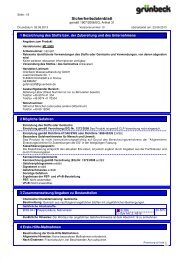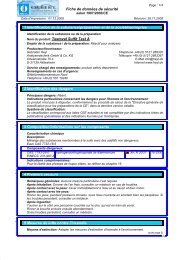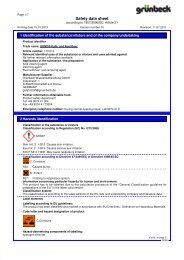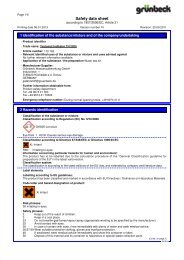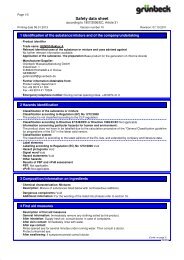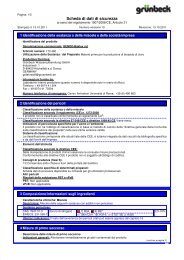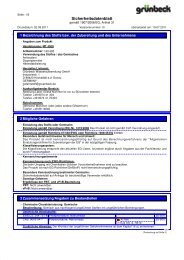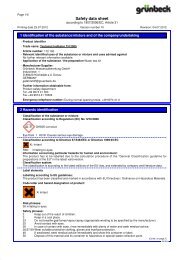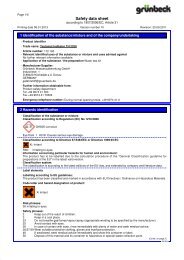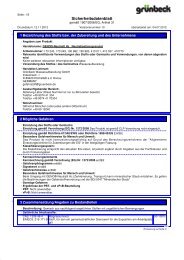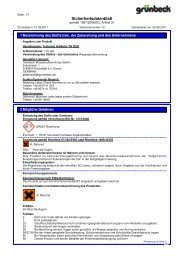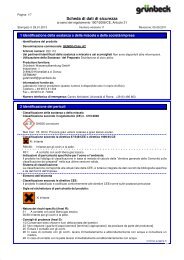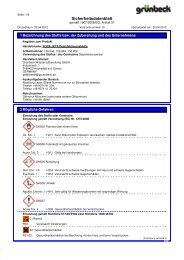SDB GENO-Chlor S EN - Grünbeck Wasseraufbereitung GmbH
SDB GENO-Chlor S EN - Grünbeck Wasseraufbereitung GmbH
SDB GENO-Chlor S EN - Grünbeck Wasseraufbereitung GmbH
Create successful ePaper yourself
Turn your PDF publications into a flip-book with our unique Google optimized e-Paper software.
35.0.5<br />
Page 1/8<br />
Safety data sheet<br />
according to 1907/2006/EC, Article 31<br />
Printing date 15.01.2013 Version number 12<br />
Revision: 01.09.2011<br />
1 Identification of the substance/mixture and of the company/undertaking<br />
· Product identifier<br />
· Trade name: <strong>G<strong>EN</strong>O</strong>®-<strong>Chlor</strong> S<br />
· Article number: 210 001, 210 050<br />
· Relevant identified uses of the substance or mixture and uses advised against<br />
No further relevant information available.<br />
· Application of the substance / the preparation Disinfectant for private pools<br />
· Manufacturer/Supplier:<br />
<strong>Grünbeck</strong> <strong>Wasseraufbereitung</strong> <strong>GmbH</strong><br />
Industriestr. 1<br />
D-89420 Höchstädt a.d. Donau<br />
GERMANY<br />
gefahrstoff@gruenbeck.de<br />
· Further information obtainable from:<br />
Product safety department<br />
Tel +49 9074 41 304<br />
Fax +49 9074 41 70304<br />
· Emergency telephone number: During normal opening times: +49 9074 41-0<br />
2 Hazards identification<br />
· Classification of the substance or mixture<br />
· Classification according to Regulation (EC) No 1272/2008<br />
GHS09 environment<br />
Aquatic Acute 1 H400 Very toxic to aquatic life.<br />
Aquatic Chronic 1 H410 Very toxic to aquatic life with long lasting effects.<br />
GHS07<br />
Acute Tox. 4 H302 Harmful if swallowed.<br />
Eye Irrit. 2 H319 Causes serious eye irritation.<br />
STOT SE 3 H335 May cause respiratory irritation.<br />
· Classification according to Directive 67/548/EEC or Directive 1999/45/EC<br />
Xn; Harmful<br />
R22: Harmful if swallowed.<br />
Xi; Irritant<br />
R36/37: Irritating to eyes and respiratory system.<br />
N; Dangerous for the environment<br />
R50/53: Very toxic to aquatic organisms, may cause long-term adverse effects in the aquatic environment.<br />
R31: Contact with acids liberates toxic gas.<br />
· Information concerning particular hazards for human and environment:<br />
The product has to be labelled due to the calculation procedure of the "General Classification guideline for<br />
preparations of the EU" in the latest valid version.<br />
· Classification system:<br />
The classification is according to the latest editions of the EU-lists, and extended by company and literature data.<br />
· Label elements<br />
· Labelling according to Regulation (EC) No 1272/2008<br />
The product is classified and labelled according to the CLP regulation.<br />
(Contd. on page 2)<br />
DE/<strong>EN</strong>
35.0.5<br />
Page 2/8<br />
Safety data sheet<br />
according to 1907/2006/EC, Article 31<br />
Printing date 15.01.2013 Version number 12<br />
Revision: 01.09.2011<br />
Trade name: <strong>G<strong>EN</strong>O</strong>®-<strong>Chlor</strong> S<br />
· Hazard pictograms<br />
GHS07 GHS09<br />
· Signal word Warning<br />
(Contd. of page 1)<br />
· Hazard-determining components of labelling:<br />
symclosene<br />
· Hazard statements<br />
H302+EUH031 Harmful if swallowed. Contact with acids liberates toxic gas.<br />
H319 Causes serious eye irritation.<br />
H335 May cause respiratory irritation.<br />
H410 Very toxic to aquatic life with long lasting effects.<br />
· Precautionary statements<br />
P101 If medical advice is needed, have product container or label at hand.<br />
P102 Keep out of reach of children.<br />
P103 Read label before use.<br />
P261 Avoid breathing dust/fume/gas/mist/vapours/spray.<br />
P280 Wear protective gloves/protective clothing/eye protection/face protection.<br />
P305+P351+P338 IF IN EYES: Rinse cautiously with water for several minutes. Remove contact lenses, if present<br />
and easy to do. Continue rinsing.<br />
P301+P312 IF SWALLOWED: Call a POISON C<strong>EN</strong>TER or doctor/physician if you feel unwell.<br />
P304+P340 IF INHALED: Remove victim to fresh air and keep at rest in a position comfortable for breathing.<br />
P312 Call a POISON C<strong>EN</strong>TER or doctor/physician if you feel unwell.<br />
P405 Store locked up.<br />
P501 Dispose of contents/container in accordance with local/regional/national/international<br />
regulations.<br />
· Other hazards<br />
· Results of PBT and vPvB assessment<br />
· PBT: Not applicable.<br />
· vPvB: Not applicable.<br />
3 Composition/information on ingredients<br />
· Chemical characterization: Mixtures<br />
· Description: Mixture of substances listed below with nonhazardous additions.<br />
· Dangerous components:<br />
CAS: 87-90-1<br />
EINECS: 201-782-8<br />
CAS: 497-19-8<br />
EINECS: 207-838-8<br />
symclosene<br />
Xn R22; Xi R36/37; O R8; N R50/53<br />
R31<br />
Ox. Sol. 2, H272; Aquatic Acute 1, H400; Aquatic Chronic 1, H410;<br />
Acute Tox. 4, H302; Eye Irrit. 2, H319; STOT SE 3, H335<br />
sodium carbonate<br />
Xi R36<br />
Eye Irrit. 2, H319<br />
· Additional information: For the wording of the listed risk phrases refer to section 16.<br />
4 First aid measures<br />
50-100%<br />
10-25%<br />
· Description of first aid measures<br />
· General information:<br />
Immediately remove any clothing soiled by the product.<br />
Symptoms of poisoning may even occur after several hours; therefore medical observation for at least 48 hours<br />
after the accident.<br />
· After inhalation:<br />
Supply fresh air; consult doctor in case of complaints.<br />
In case of unconsciousness place patient stably in side position for transportation.<br />
· After skin contact: Immediately wash with water and soap and rinse thoroughly.<br />
(Contd. on page 3)<br />
DE/<strong>EN</strong>
35.0.5<br />
Page 3/8<br />
Safety data sheet<br />
according to 1907/2006/EC, Article 31<br />
Printing date 15.01.2013 Version number 12<br />
Revision: 01.09.2011<br />
Trade name: <strong>G<strong>EN</strong>O</strong>®-<strong>Chlor</strong> S<br />
· After eye contact:<br />
Rinse opened eye for several minutes under running water. If symptoms persist, consult a doctor.<br />
· After swallowing:<br />
Do not induce vomiting; call for medical help immediately.<br />
Rinse out mouth and then drink plenty of water.<br />
· Information for doctor:<br />
· Most important symptoms and effects, both acute and delayed No further relevant information available.<br />
· Indication of any immediate medical attention and special treatment needed<br />
No further relevant information available.<br />
5 Firefighting measures<br />
· Extinguishing media<br />
· Suitable extinguishing agents:<br />
Fire-extinguishing powder<br />
Carbon dioxide<br />
· For safety reasons unsuitable extinguishing agents:<br />
Foam<br />
Water<br />
· Special hazards arising from the substance or mixture<br />
In case of fire, the following can be released:<br />
Nitrogen oxides (NOx)<br />
Hydrogen chloride (HCl)<br />
· Advice for firefighters<br />
· Protective equipment: Wear self-contained respiratory protective device.<br />
6 Accidental release measures<br />
· Personal precautions, protective equipment and emergency procedures<br />
Wear protective equipment. Keep unprotected persons away.<br />
Avoid formation of dust.<br />
Ensure adequate ventilation<br />
· Environmental precautions:<br />
Do not allow product to reach sewage system or any water course.<br />
Inform respective authorities in case of seepage into water course or sewage system.<br />
Keep contaminated washing water and dispose of appropriately.<br />
· Methods and material for containment and cleaning up:<br />
Dispose contaminated material as waste according to item 13.<br />
Ensure adequate ventilation.<br />
Do not flush with water or aqueous cleansing agents<br />
· Reference to other sections<br />
See Section 7 for information on safe handling.<br />
See Section 8 for information on personal protection equipment.<br />
See Section 13 for disposal information.<br />
7 Handling and storage<br />
· Handling:<br />
· Precautions for safe handling<br />
Store in cool, dry place in tightly closed receptacles.<br />
Provide suction extractors if dust is formed.<br />
Restrict the quantity stored at the work place.<br />
Do not refill residue into storage receptacles.<br />
· Information about fire - and explosion protection: Keep respiratory protective device available.<br />
· Conditions for safe storage, including any incompatibilities<br />
· Storage:<br />
· Requirements to be met by storerooms and receptacles:<br />
Store only in unopened original receptacles.<br />
Store in a cool location.<br />
· Information about storage in one common storage facility: Do not store together with acids.<br />
(Contd. of page 2)<br />
(Contd. on page 4)<br />
DE/<strong>EN</strong>
35.0.5<br />
Page 4/8<br />
Safety data sheet<br />
according to 1907/2006/EC, Article 31<br />
Printing date 15.01.2013 Version number 12<br />
Revision: 01.09.2011<br />
Trade name: <strong>G<strong>EN</strong>O</strong>®-<strong>Chlor</strong> S<br />
· Further information about storage conditions:<br />
Store in cool, dry conditions in well sealed receptacles.<br />
Protect from heat and direct sunlight.<br />
Protect from humidity and water.<br />
· Storage class: 11<br />
· Specific end use(s) No further relevant information available.<br />
8 Exposure controls/personal protection<br />
· Additional information about design of technical facilities: No further data; see item 7.<br />
(Contd. of page 3)<br />
· Control parameters<br />
· Ingredients with limit values that require monitoring at the workplace:<br />
The product does not contain any relevant quantities of materials with critical values that have to be monitored at<br />
the workplace.<br />
· Additional information: The lists valid during the making were used as basis.<br />
· Exposure controls<br />
· Personal protective equipment:<br />
· General protective and hygienic measures:<br />
Keep away from foodstuffs, beverages and feed.<br />
Immediately remove all soiled and contaminated clothing<br />
Wash hands before breaks and at the end of work.<br />
Avoid contact with the eyes and skin.<br />
· Respiratory protection:<br />
In case of brief exposure or low pollution use respiratory filter device. In case of intensive or longer exposure use<br />
self-contained respiratory protective device.<br />
· Protection of hands:<br />
The glove material has to be impermeable and resistant to the product/ the substance/ the preparation.<br />
Selection of the glove material on consideration of the penetration times, rates of diffusion and the degradation<br />
· Material of gloves<br />
The selection of the suitable gloves does not only depend on the material, but also on further marks of quality and<br />
varies from manufacturer to manufacturer. As the product is a preparation of several substances, the resistance of<br />
the glove material can not be calculated in advance and has therefore to be checked prior to the application.<br />
· Penetration time of glove material<br />
The exact break through time has to be found out by the manufacturer of the protective gloves and has to be<br />
observed.<br />
· For the permanent contact gloves made of the following materials are suitable:<br />
Nitrile rubber, NBR<br />
Butyl rubber, BR<br />
Fluorocarbon rubber (Viton)<br />
PVC gloves<br />
· Eye protection:<br />
Tightly sealed goggles<br />
· Body protection: Protective work clothing<br />
9 Physical and chemical properties<br />
· Information on basic physical and chemical properties<br />
· General Information<br />
· Appearance:<br />
Form: Tablets<br />
Colour: Colourless<br />
· Odour: Like chlorine<br />
· pH-value (10 g/l) at 20°C: 5,5 - 7,5<br />
· Change in condition<br />
Melting point/Melting range: 225 - 240°C<br />
(Contd. on page 5)<br />
DE/<strong>EN</strong>
35.0.5<br />
Page 5/8<br />
Safety data sheet<br />
according to 1907/2006/EC, Article 31<br />
Printing date 15.01.2013 Version number 12<br />
Revision: 01.09.2011<br />
Trade name: <strong>G<strong>EN</strong>O</strong>®-<strong>Chlor</strong> S<br />
· Flash point: Not applicable.<br />
· Flammability (solid, gaseous): Product is not flammable.<br />
· Self-igniting: Product is not selfigniting.<br />
· Danger of explosion: Product does not present an explosion hazard.<br />
· Density at 20°C: 2,13 g/cm³<br />
· Solubility in / Miscibility with<br />
water at 25°C: 12 g/l<br />
· Solvent content:<br />
Organic solvents: 0,0 %<br />
VOC (EC) 0,00 %<br />
0,00 %<br />
Solids content: 100,0 %<br />
· Other information No further relevant information available.<br />
10 Stability and reactivity<br />
· Reactivity<br />
· Chemical stability<br />
· Thermal decomposition / conditions to be avoided: No decomposition if used according to specifications.<br />
· Possibility of hazardous reactions<br />
Contact with acids releases toxic gases.<br />
Strong exothermic reaction with acids.<br />
· Conditions to avoid No further relevant information available.<br />
· Incompatible materials: No further relevant information available.<br />
· Hazardous decomposition products:<br />
<strong>Chlor</strong>ine<br />
Nitrogen oxides (NOx)<br />
11 Toxicological information<br />
(Contd. of page 4)<br />
· Information on toxicological effects<br />
· Acute toxicity:<br />
· LD/LC50 values relevant for classification:<br />
87-90-1 symclosene<br />
Oral LD50 406 mg/kg (rat)<br />
· Primary irritant effect:<br />
· on the skin: No irritant effect.<br />
· on the eye: Irritating effect.<br />
· Sensitization: No sensitizing effects known.<br />
· Additional toxicological information:<br />
The product shows the following dangers according to the calculation method of the General EU Classification<br />
Guidelines for Preparations as issued in the latest version:<br />
Harmful<br />
Irritant<br />
12 Ecological information<br />
· Toxicity<br />
· Aquatic toxicity: No further relevant information available.<br />
· Persistence and degradability No further relevant information available.<br />
· Behaviour in environmental systems:<br />
· Bioaccumulative potential No further relevant information available.<br />
· Mobility in soil No further relevant information available.<br />
· Ecotoxical effects:<br />
· Remark: Very toxic for fish<br />
(Contd. on page 6)<br />
DE/<strong>EN</strong>
35.0.5<br />
Page 6/8<br />
Safety data sheet<br />
according to 1907/2006/EC, Article 31<br />
Printing date 15.01.2013 Version number 12<br />
Revision: 01.09.2011<br />
Trade name: <strong>G<strong>EN</strong>O</strong>®-<strong>Chlor</strong> S<br />
(Contd. of page 5)<br />
· Additional ecological information:<br />
· General notes:<br />
Water hazard class 2 (German Regulation) (Self-assessment): hazardous for water<br />
Do not allow undiluted product or large quantities of it to reach ground water, water course or sewage system.<br />
Also poisonous for fish and plankton in water bodies.<br />
Very toxic for aquatic organisms<br />
· Results of PBT and vPvB assessment<br />
· PBT: Not applicable.<br />
· vPvB: Not applicable.<br />
· Other adverse effects No further relevant information available.<br />
13 Disposal considerations<br />
· Waste treatment methods<br />
· Recommendation<br />
Must not be disposed together with household garbage. Do not allow product to reach sewage system.<br />
Must be specially treated adhering to official regulations.<br />
· Uncleaned packaging:<br />
· Recommendation:<br />
Disposal must be made according to official regulations.<br />
Empty contaminated packagings thoroughly. They may be recycled after thorough and proper cleaning.<br />
Packagings that may not be cleansed are to be disposed of in the same manner as the product.<br />
· Recommended cleansing agents: Water, if necessary together with cleansing agents.<br />
14 Transport information<br />
· UN-Number<br />
· ADR, IMDG, IATA UN3077<br />
· UN proper shipping name<br />
· ADR 3077 <strong>EN</strong>VIRONM<strong>EN</strong>TALLY HAZARDOUS SUBSTANCE, SOLID,<br />
N.O.S. (TRICHLOROISOCYANURIC ACID)<br />
· IMDG, IATA <strong>EN</strong>VIRONM<strong>EN</strong>TALLY HAZARDOUS SUBSTANCE, SOLID, N.O.S.<br />
(TRICHLOROISOCYANURIC ACID)<br />
· Transport hazard class(es)<br />
· ADR<br />
· Class 9 Miscellaneous dangerous substances and articles.<br />
· Label 9<br />
· IMDG, IATA<br />
· Class 9 Miscellaneous dangerous substances and articles.<br />
· Label 9<br />
· Packing group<br />
· ADR, IMDG, IATA III<br />
· Environmental hazards:<br />
· Marine pollutant: No<br />
· Special marking (ADR): Symbol (fish and tree)<br />
· Special precautions for user Warning: Miscellaneous dangerous substances and articles.<br />
· Danger code (Kemler): 90<br />
(Contd. on page 7)<br />
DE/<strong>EN</strong>
35.0.5<br />
Page 7/8<br />
Safety data sheet<br />
according to 1907/2006/EC, Article 31<br />
Printing date 15.01.2013 Version number 12<br />
Revision: 01.09.2011<br />
Trade name: <strong>G<strong>EN</strong>O</strong>®-<strong>Chlor</strong> S<br />
· EMS Number: F-A,S-F<br />
· Transport in bulk according to Annex II of<br />
MARPOL73/78 and the IBC Code Not applicable.<br />
· Transport/Additional information:<br />
· ADR<br />
· Tunnel restriction code E<br />
(Contd. of page 6)<br />
· UN "Model Regulation": UN3077, <strong>EN</strong>VIRONM<strong>EN</strong>TALLY HAZARDOUS SUBSTANCE, SOLID,<br />
N.O.S. (TRICHLOROISOCYANURIC ACID), 9, III<br />
15 Regulatory information<br />
· Safety, health and environmental regulations/legislation specific for the substance or mixture<br />
· Labelling according to Regulation (EC) No 1272/2008<br />
The product is classified and labelled according to the CLP regulation.<br />
· Hazard pictograms<br />
GHS07 GHS09<br />
· Signal word Warning<br />
· Hazard-determining components of labelling:<br />
symclosene<br />
· Hazard statements<br />
H302+EUH031 Harmful if swallowed. Contact with acids liberates toxic gas.<br />
H319 Causes serious eye irritation.<br />
H335 May cause respiratory irritation.<br />
H410 Very toxic to aquatic life with long lasting effects.<br />
· Precautionary statements<br />
P101 If medical advice is needed, have product container or label at hand.<br />
P102 Keep out of reach of children.<br />
P103 Read label before use.<br />
P261 Avoid breathing dust/fume/gas/mist/vapours/spray.<br />
P280 Wear protective gloves/protective clothing/eye protection/face protection.<br />
P305+P351+P338 IF IN EYES: Rinse cautiously with water for several minutes. Remove contact lenses, if present<br />
and easy to do. Continue rinsing.<br />
P301+P312 IF SWALLOWED: Call a POISON C<strong>EN</strong>TER or doctor/physician if you feel unwell.<br />
P304+P340 IF INHALED: Remove victim to fresh air and keep at rest in a position comfortable for breathing.<br />
P312 Call a POISON C<strong>EN</strong>TER or doctor/physician if you feel unwell.<br />
P405 Store locked up.<br />
P501 Dispose of contents/container in accordance with local/regional/national/international<br />
regulations.<br />
· Chemical safety assessment: A Chemical Safety Assessment has not been carried out.<br />
16 Other information<br />
This information is based on our present knowledge. However, this shall not constitute a guarantee for any specific<br />
product features and shall not establish a legally valid contractual relationship.<br />
· Relevant phrases<br />
H272 May intensify fire; oxidiser.<br />
H302 Harmful if swallowed.<br />
H319 Causes serious eye irritation.<br />
H335 May cause respiratory irritation.<br />
H400 Very toxic to aquatic life.<br />
H410 Very toxic to aquatic life with long lasting effects.<br />
R22 Harmful if swallowed.<br />
R31 Contact with acids liberates toxic gas.<br />
R36 Irritating to eyes.<br />
(Contd. on page 8)<br />
DE/<strong>EN</strong>
35.0.5<br />
Page 8/8<br />
Safety data sheet<br />
according to 1907/2006/EC, Article 31<br />
Printing date 15.01.2013 Version number 12<br />
Revision: 01.09.2011<br />
Trade name: <strong>G<strong>EN</strong>O</strong>®-<strong>Chlor</strong> S<br />
R36/37 Irritating to eyes and respiratory system.<br />
R50/53 Very toxic to aquatic organisms, may cause long-term adverse effects in the aquatic environment.<br />
R8 Contact with combustible material may cause fire.<br />
(Contd. of page 7)<br />
· Department issuing MSDS: Laboratory<br />
· Contact: Mrs. Gerstmeier<br />
· Abbreviations and acronyms:<br />
RID: Règlement international concernant le transport des marchandises dangereuses par chemin de fer (Regulations Concerning the International<br />
Transport of Dangerous Goods by Rail)<br />
ICAO: International Civil Aviation Organization<br />
ADR: Accord européen sur le transport des marchandises dangereuses par Route (European Agreement concerning the International Carriage of<br />
Dangerous Goods by Road)<br />
IMDG: International Maritime Code for Dangerous Goods<br />
IATA: International Air Transport Association<br />
GHS: Globally Harmonized System of Classification and Labelling of Chemicals<br />
VOC: Volatile Organic Compounds (USA, EU)<br />
LC50: Lethal concentration, 50 percent<br />
LD50: Lethal dose, 50 percent<br />
DE/<strong>EN</strong>



